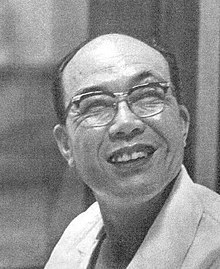Sōichirō Honda
Sōichirō Honda ( Japanese 本田 宗一郎 Honda Sōichirō ; born November 17, 1906 in Kōmyō , Iwata County (today: Hamamatsu ), Shizuoka Prefecture , Japan ; † August 5, 1991 ) was a Japanese entrepreneur.
In 1948, Honda founded the Honda Corporation , which quickly grew into one of the most important automobile and engine manufacturers. He remained President of Honda until 1973.
He spent his childhood in his father's bicycle workshop, whom he helped with repairs. At the age of 16, Honda went to Tokyo , where he accepted an apprenticeship in a car repair shop. There he worked as a mechanic for six years until he returned to his hometown of Kōmyō in 1928 at the age of 22 to open his own workshop.
At this time Honda began to take part in various races, but after a serious traffic accident in which he sustained several serious injuries and broken bones, his wife asked him to give up this hobby.
Underutilized by his work in the workshop, he founded Tokai Seiki Heavy Industry (TSHI) in 1937 , a company that produced piston rings . Soichiro Honda sold this to Toyota eleven years later (1948) for 450,000 yen .
In the same year (1948) Honda began manufacturing motorcycles as President of the Honda Corporation . Thanks to intelligent marketing strategies and excellent technical performance, the group succeeded a few years later in becoming the motorcycle manufacturer with the highest sales figures worldwide. In 1959, Honda started selling its motorcycles in the United States. In 1963, with his help, automobiles such as the Honda T360 and Honda S500 were developed. Sōichirō Honda was personally present on August 29, 1963 when the S500 was first presented to the European public on a Rhine steamer near Koblenz.
Sōichirō Honda remained president of the company until his retirement in 1973. Even after his official resignation, he devoted the majority of his time to work in connection with the Honda Corporation.
In 1991 Honda was awarded the James Watt Medal . He died of liver disease that same year.
Individual evidence
- ↑ auto, motor und sport , issue 19/1963, page 26
Web links
- Literature by and about Sōichirō Honda in the catalog of the German National Library
- Motorcycle Hall of Fame - Soichiro Honda (Engl.)
| personal data | |
|---|---|
| SURNAME | Honda, Sōichirō |
| ALTERNATIVE NAMES | 本田 宗一郎 (Japanese) |
| BRIEF DESCRIPTION | Japanese entrepreneur |
| DATE OF BIRTH | 17th November 1906 |
| PLACE OF BIRTH | Kōmyō (Shizuoka) , Iwata-gun (Shizuoka) , Shizuoka Prefecture , Japan |
| DATE OF DEATH | 5th August 1991 |
